Ardha Matsyendrasana, Half Lord of the Fishes Pose, Half Spinal Twist Pose or Vakrasana is an asana. Sanskrit: अर्धमत्स्येन्द्रासन; Ardha – Half, Matsyendra – King of the fish, Asana – Pose; Pronounced As: ARE-dah MAT-see-en-DRAHS-anna
The yogi Matsyendranath is honored with the name of this asana. The name Ardha Matsyendrasana is derived from the Sanskrit words “ardha” (half), “matsya” (fish), “Indra” (king), and “asana” (posture). Vakrasana is another name for this asana. In Sanskrit, ‘Vakra’ signifies twisted. Half Lord of the Fishes Pose, and Half Spinal Twist are two more names for this asana. It is a sitting spinal twist that may be done in various ways. This is one of the twelve basic asanas taught in Hatha Yoga classes. Continue reading to know more.
In This Article
Everything You Need To Know About The Ardha Matsyendrasana
What You Should Know Before You Do This Asana
This asana must be practiced either first thing in the morning or at least four to six hours after a meal. Your stomach and bowels must be empty when you practice this asana. The food must be digested so that there is enough energy to expend during the practice.
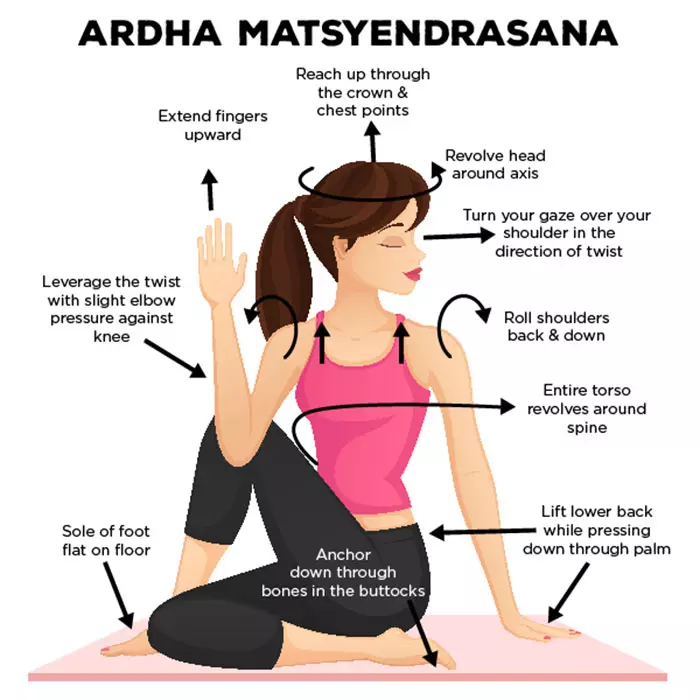
- Level: Basic
- Style: Hatha Yoga
- Duration: 30 To 60 Seconds
- Repetition: Do it on the right side first and then on the left
- Stretches: Hips, Shoulders, Neck
- Strengthens: Spine, Digestive System, Urinary System, Reproductive System
How To Do Ardha Matsyendrasana
- Sit erect with your legs stretched out. Make sure that your feet are placed together and your spine is absolutely erect.
- Now, bend your left leg such that the heel of the left foot lies next to the right hip. You could also keep the left leg stretched out if you like.
- Then, place the right leg next to the left knee by taking it over the knee.
- Twist your waist, neck, and shoulders towards the right, and set your gaze over your right shoulder. Make sure your spine is erect.
- There are many ways you can place your arms to increase and decrease the stretch. But to do it simply, you can place the right hand behind you, and the left hand on the right knee.
- Hold the pose for a few seconds, about 30 to 60 as you breathe slowly, yet deeply.
- Exhale and release the right hand, and then the waist, chest, and finally the neck. Relax as you sit straight.
- Repeat the steps on the other side, and then exhale and come back to the front.
Precautions And Contraindications
Now that you know how to do half spinal twist pose, let’s have a look at few points of caution you must keep in mind while you do this asana.
- This asana must be avoided during pregnancy and menstruation as it entails a strong twist at the abdomen.
- People who have recently undergone abdominal, heart or brain surgeries, should not practice this asana.
- Those with a hernia or peptic ulcers must do this asana carefully and under the supervision of a certified yoga instructor.
- People who have a minor slipped disc problem will benefit from this asana. But they must do it under supervision, and with a doctor’s approval. If you have a severe spinal problem or a severe slipped disc problem, it is best to avoid this asana.
Beginner’s Tips
The many hand variations in this pose can make it quite hard for beginners to adapt. First of all, make sure you sit on a blanket and practice this pose. Next, before you try the hand and arm variations, just wrap one arm around the raised leg, and hug your thigh to your torso. With practice, you can start trying other variations.
Advanced Pose Variations
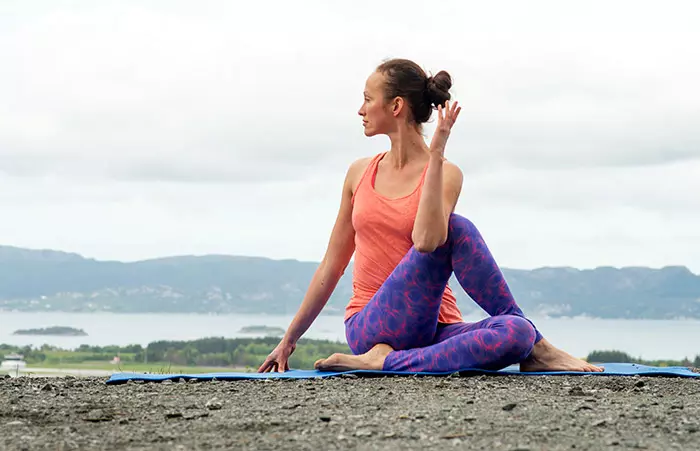
Image: Shutterstock
This is an advanced pose you can try to deepen the stretch.
- If your hips and spine are flexible enough, you can bring the upper left arm to the outside of the upper right thigh.
- Keeping your legs placed the way they should be, exhale and turn your gaze to the right.
- Lean away from the upper thigh, and bend the left elbow such that it presses against the outside of the upper right thigh.
- Now, cuddle your torso against your thigh, and work the upper left arm on the outer leg until the back of the shoulder presses against the knee.
- Let your elbow stay bent, and hand raised towards the ceiling. Lean in to form a slight upper back bend. Your shoulder blades must be firm against the back. Make sure you lift the front of your torso through the top sternum.
Benefits Of The Half Spinal Twist
These are some amazing benefits of the Ardha Matsyendrasana.
- This asana makes the spine more flexible. It tones the spinal nerves and improves the way the spinal cord functions.
- This asana helps to stretch the muscles on one side of the body while compressing the muscles on the other side.
- This asana helps relieve stiffness and back pain from between the vertebrae.
- This asana helps to cure a slipped disc.
- Getting into a twist massages the abdominal organs, therefore increasing the digestive juices and increasing the functioning of the digestive system.
- This asana helps to massage and stimulate the pancreas, and thus, helps those suffering from diabetes.
- This asana helps to regulate the secretion of both adrenalin and bile.
- The asana helps to relieve stress and tension that is trapped in the back.
- It also helps to open up the chest and increase the supply of oxygen to the lungs.
- It helps to loosen the joints at the hip and also releases stiffness.
- It increases the circulation of blood, purifies the blood, and detoxifies the internal organs.
- This asana increases the circulation of blood to the pelvic area, thus providing nutrients, blood, and oxygen, and improving the health of the reproductive system as well as the urinary system.
- This asana also helps to cure urinary tract infections.
- This asana is also beneficial for menstrual disorders.
The Science Behind The Vakrasana
After a tough, challenging workout, a twist like the Ardha Matsyendrasana can be extremely relaxing. But this pose is also fortifying and has a whole lot of amazing benefits. So don’t let yourself get too complacent as you do this asana. Getting into the pose is easy, but the real goodness is in the action of twisting. When you contract your torso muscles and elongate and rotate your spine while deepening your breath, you are greatly benefitted.
Be conscious and work towards gaining the benefits of Ardha Matsyendrasana step by step. This asana will help you stretch your outer hips and thighs. It also opens up the front of your shoulders and chest as it builds strength along the sides of your body. The twisting will keep your spine healthy as it squeezes and rehydrates the spongy discs that lie between the vertebrae. These tend to get compressed as you age.
Try to avoid slouching and slumping during this asana – it will limit the degree of spinal rotation that you are capable of. For a deep twist, you must lengthen your spine and make enough space between your vertebrae. Use your breath to deepen the stretches. Inhale and lengthen yourself, and exhale and twist deeper.
If this asana is practiced with dedication, this deep-seated twist can confront reality and let you know what is really going on in your hips, spine, and even your mind. It lets you take account of a bloated stomach, and also if your breath is constricted or muscles are stiff.
Preparatory Poses
Baddha Koṇāsana
Janusirsasana
Virasana
Bharadvaja’s Twist
Supta Padangusthasana
Follow-Up Poses
Paschimottanasana
Janusirsasana
Getting your body into a deep twist such as this asana is not only beneficial but also relaxing. Once you release the twist, you will know what you feel mentally, physically, and emotionally.
One of the twelve asanas offered in Hatha Yoga courses is Ardha Matsyendrasana. This asana helps extend your hips and thighs on the outside. It also strengthens your body’s sides while opening the front of your shoulders and chest. In addition, it rehydrates and squeezes the spongy discs that lay between the vertebrae, as twisting will maintain your spine healthy. This asana should be done either first thing in the morning or six hours after eating. Also, it must be done with an empty stomach and bowels.
Frequently Asked Questions
What is the difference between Matsyendrasana and Ardha Matsyendrasana?
Poorna Matsyendrasana is the full spinal twist, and the back foot rests on the thigh, like padmasana. In Ardha-Matsyendrasana, the back foot rests on the floor.
How many times should I do Ardha Matsyendrasana?
Ardha Matsyendrasana can be done daily. Do three reps, holding each briefly.
Related
The following two tabs change content below.
- Author

Shirin Mehdi
A jack of many trades and a master of some, Shirin is a writer, a fashion designer, and a chef… more



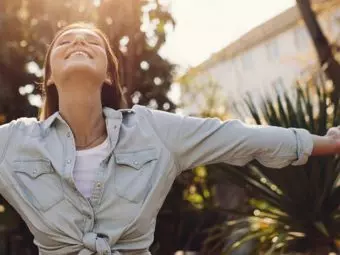 7 Best Yoga Poses To Relieve Allergic Rhinitis
7 Best Yoga Poses To Relieve Allergic Rhinitis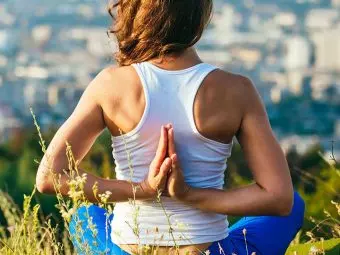 24 Effective Yoga Poses For Back Pain – Get Instant Relief
24 Effective Yoga Poses For Back Pain – Get Instant Relief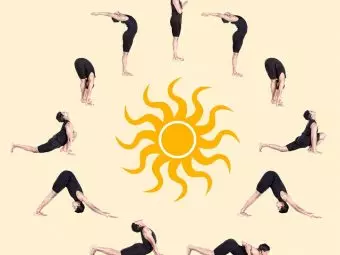 7 Yoga Poses For Beauty
7 Yoga Poses For Beauty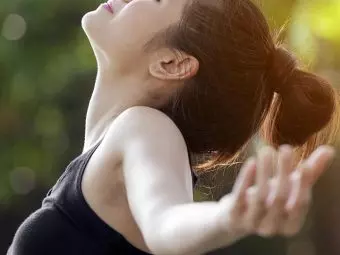 5 Deep Breathing Exercises Of Pranayama For Good Oxygen Levels
5 Deep Breathing Exercises Of Pranayama For Good Oxygen Levels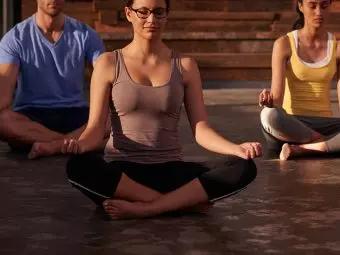 20 Things You Must Know Before You Start Practicing Yoga
20 Things You Must Know Before You Start Practicing Yoga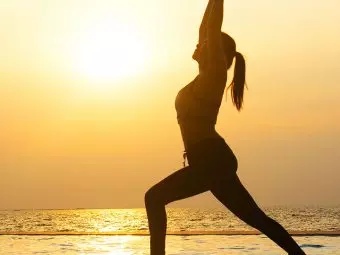 What Is The Best Time To Do Yoga?
What Is The Best Time To Do Yoga?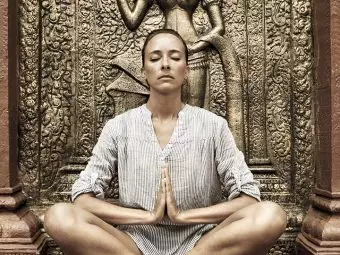 Reiki Meditation – How To Do And What Are Its Benefits?
Reiki Meditation – How To Do And What Are Its Benefits?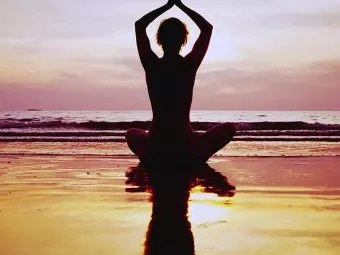 7 Easy Steps To Do Pranic Healing Meditation
7 Easy Steps To Do Pranic Healing Meditation 5 Effective Yoga Poses To Increase Your Stamina
5 Effective Yoga Poses To Increase Your Stamina